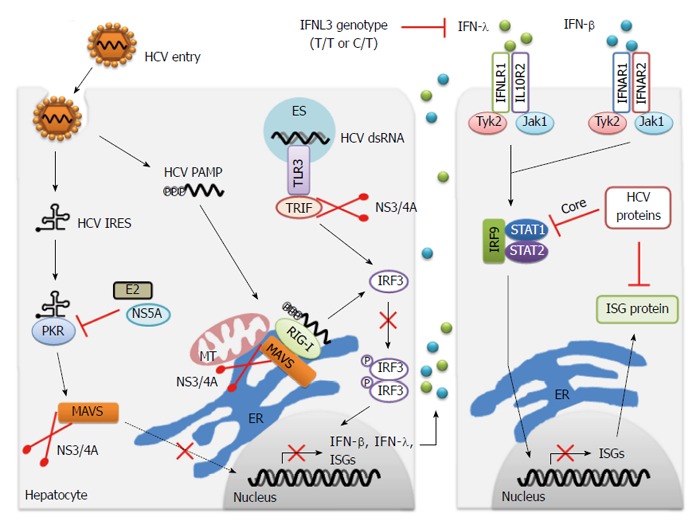Figure 2.

Innate immune evasion of hepatitis C virus infection. Multiple strategies to disrupt both IFN induction and response pathways are responsible for chronic hepatitis C virus (HCV) infection during viral infection. Notably, HCV NS3/4A protease cleaves the adaptor proteins MAVS and TRIF, contributing to the blockage of downstream signaling of PKR, RIG-I and TLR3, and prevention of IFN production. HCV E2 and NS5A proteins suppress the function of PKR by direct binding to this kinase. IFN-β and IFN-λ bind to their distinct receptors and induce the formation of IFN-stimulated gene factor-3 (ISGF3), comprising phosphorylated STAT1, STAT2 and IRF9 through the common JAK/STAT pathway. HCV core and other viral proteins inhibit the activation of STAT signaling, and therefore repress the production of ISGs. The function of specific ISG protein is also suppressed by HCV proteins. Additionally, the unfavorable IFNL3 genotype (T/T or C/T) leads to less expression of IFN-λ, which attenuates the antiviral effect of IFN-λ on HCV infection. MT: Mitochondria; ER: Endoplasmic reticulum; ES: Endosome; PAMP: Pathogen-associated molecular pattern; IRES: Internal ribosomal entry site; TLR: Toll-like receptor; IFN: Interferon; MAVS: Mitochondrial antiviral signaling; ISGs: IFN-stimulated genes; TRIF: TIR-domain-containing adaptor-inducing interferon-β.
